Honored by the Jade Emperor – The Chinese Zodiac
PRIMITIVE - Thursday, December 31, 2015By Misaki Imagawa
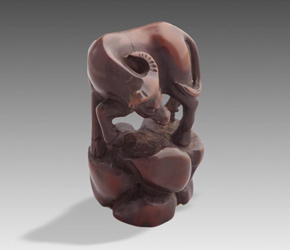 |
|
A long, long time ago in the Far East, the Jade Emperor – supreme deity, ruler of the Heavens, and first emperor of China – decided to hold a race. He called on all the animals in his kingdom and decreed that the first twelve to reach him would each represent a year of the astrological cycle; but to reach him, the animals needed to cross a wide river. The first animal to act was the clever, ambitious rat. He hopped onto an ox's back and when they reached the far shore, jumped ahead and won the race. The ox lumbered right behind and came in second. In third place came the tiger, his majestic muscles carrying him easily across the water right up to the feet of the Jade Emperor.
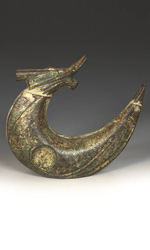 |
|
Leaping from boulder to boulder to keep dry was a rabbit; but halfway across the river he slipped and tumbled into the water. Luckily, a floating log was nearby. He grabbed onto it, but to his dismay the current was taking him further away from the shore. Far above the river, a dragon glided through the clouds. Although he could have easily won the race, he had noticed a village suffering from droughts and he delayed to deliver some much needed rain. Now he looked down and saw the rabbit drifting helplessly, so he let out a huff of wind and pushed the poor creature to the shore. The grateful rabbit scampered onto the land, shook the water from his fur, and finished the race in fourth place. The dragon landed by the emperor and came in fifth right after the rabbit. The rabbit rubbed up against the dragon to display his affection and gratitude.
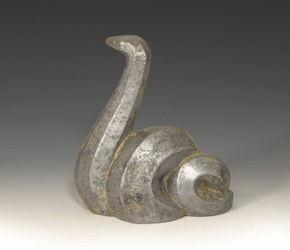 |
|
Right after the dragon landed a horse scrambled up onto the shore, but the moment his hooves touched the ground a snake that had been coiled around its leg slithered out in front. The horse reared back in fright, and in that moment the snake made it to the emperor and came in sixth. The horse regained its composure and came in seventh. Next to arrive were the sheep, monkey and rooster, all of whom had been working together as a team to paddle a raft across the river. When they pulled the raft to shore, they dutifully marched to the feet of the emperor in the same order they had been seated, thus coming in eighth, ninth and tenth place. On their heels was a dog, tail wagging in excitement despite finishing in eleventh place. He, like all the other animals knew it mattered not in what place they finished, for finishing at all meant they were winners. That’s why they all cheered as a boar crossed the finish line in twelfth place. He had stopped along the way to prepare a feast for all the other animals to eat and had to keep the food dry as he crossed the river. The Jade Emperor surveyed the animals with a pleased smile and then declared them the twelve zodiacs.
There are many variations of the story of how the Chinese zodiac came into existence, invariably because the exact historical origins have been lost in time. Ancient references to the zodiac animals date to carvings found on oracle bones from the Shang period (1766-1121 BC). In the subsequent Zhou dynasty (1046-256 BC), the Chinese astrological system of a cycle of twelve years was established. The earliest written records of the zodiacs used specifically to reference a particular year come from the Tang dynasty (618-1367), from which point the custom became popularized and remained in use until the Western calendar was introduced.
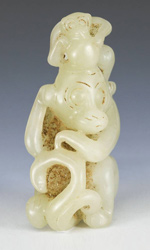 |
|
There has always been debate about the absence of a cat in the zodiac. Stories have attempted to explain this, telling tales of how the rat deceived the cat or even pushed him off the ox's back. However, scholars generally agree that the historical reason is because the zodiacs were chosen before cats were introduced to China from India with the arrival of Buddhism around the third century BC. Nevertheless, one variation of the zodiac story begins with Buddha calling all the animals to him as he lay on his death bed. Ultimately, the story revolves around the very human characteristics the animals possessed that captivated the people. To this day, the zodiacs are deeply imbedded in many Eastern cultures. Some individuals go as far as making major life decisions such as occupation choices or marriage based on zodiac signs and their compatibility.
Historically, the zodiac signs have played an important role in the arts. From scroll paintings to decorative designs on ceramic wares to textiles designs and sculpture, the zodiacs became popular motifs. Like most images in Chinese art, each animal held symbolic meaning, enhancing the works they adorned. The following are the animals that make up the Chinese zodiac, their characteristics and the symbolism they represent:
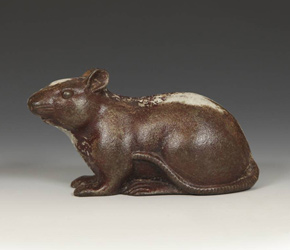 |
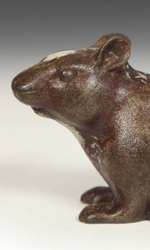 |
||
Rat: In sharp contrast to Western views of the rat as vermin, in the East they are admired for their quick wit and ability to adapt to any situation. For such a small animal they are surprisingly intelligent and skillful at gathering and hoarding food; and for this reason they are associated with wealth and abundance, as well as fertility – all desirable aspects in life.
Ox: For thousands of years the ox was crucial to a farmer's success. This powerful animal has long been synonymous with agriculture and springtime. Hardworking and industrious are among its highest qualities. In a series of Zen poems illustrated in the 11th century, the taming of a wild ox is symbolic of a person attaining enlightenment and purity of mind.
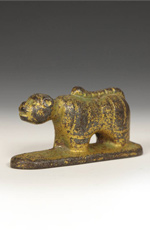 |
|
Tiger: One of the oldest and most revered animals, the tiger has been regarded as a protective entity for thousands of years. In what is known simply as the 'Four Symbols,' an ancient astrological configuration representing the four directions and four seasons, a white tiger guards the West. Together with the dragon in the East, the tiger has often been carved on either side of houses and graves as guardian figures. The tiger symbolizes strength, valor and military prowess. The striped fur on its forehead also reads 'king' making it especially valued as a powerful and protective motif.
Rabbit: Just as cultures in the West see the face of a man in the moon, in Asia they see a rabbit. Stories say it is grinding herbal medicine in a mortar that will grant immortality. Combined with a rabbit's natural proclivity for producing many offspring, it is often associated with fertility and the longevity of a family through a healthy line of descendents. Symbolic of vigilance, deftness and intelligence, the rabbit also represents all the yin forces in classical Chinese philosophy due to its association with the moon.
Dragon: As the only mythical creature in the zodiac, the dragon not only ranks highest in the Chinese animal hierarchy, it represents all the forces of nature. Able to control fire and produce rain, fly through the sky and swim underwater, the dragon inspires awe in all; but unlike its Western counterpart, the Eastern dragon is a benevolent entity that protects and aids the people. It is the ultimate symbol of strength and power, associated with imperial authority. In fact, this zodiac sign is so popular that some parents in Asia time the birth of their children to the year of the dragon.
Snake: Although the ancient people referred to the snake as the 'little dragon,' their symbolic meanings are very different. The snake is mysterious and crafty, representing longevity and the fertility of both people and the land. Many traditional gods and goddesses were portrayed as having the body of a snake. Far from being portrayed as a treacherous creature, the snake even symbolizes timeless love. In the Legend of the White Snake, a snake transforms into a human and falls in love with a mortal man. Even after discovering her true identity their love conquers all obstacles.
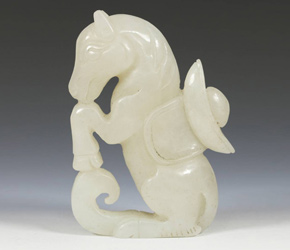 |
|
Horse: One of the earliest domesticated animals, the horse was valued as both a riding and pack animal. A person on horseback had great military advantage; thus this astrological sign alludes to high status, wealth and power. In China it is often said that good fortune is borne on the back of a galloping horse. Forging ahead with tireless stamina, they are symbols of perseverance and success, especially when associated with academic pursuits.
Sheep: In Chinese, the same character is used for sheep and goats. It also accompanies the word yang in the yin and yang philosophy, representing the masculine and all positive aspects in nature. The word for sheep is also a playful pun on the word 'auspiciousness' and its use as a fortunate motif can be traced back to the Han dynasty (206 BC - 220 AD). Symbolizing peace, harmony, prosperity and filial piety, the image can be seen on many house roofs for good luck.
Monkey: The intelligence of monkeys was not lost on ancient people. The Chinese character for monkey sounds the same as the word meaning 'nobleman' or 'high official.' Motifs of this zodiac sign were often messages of well wishes in one's pursuit of gaining high governmental offices. Achieving high rank was also synonymous with wealth and honor. The image of a monkey on horseback took the message a step further, wishing swift success.
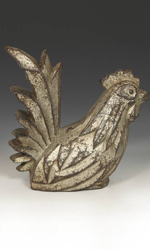 |
|
Rooster: As in many other cultures throughout the world, the crowing of a rooster signals the start of a new day. Just as they dispel the darkness of night, it is believed they possess the ability to drive away evil spirits and their images often appear on house gates for protection. The rooster is also a symbol of good luck, courage, benevolence, high rank and faithfulness – after all, a rooster never fails to announce the dawn every day.
Dog: There is an old saying that states if an unfamiliar dog suddenly appears on your doorsteps it is a sign of future prosperity. The dog's sense of loyalty has always been greatly valued as well as its protective nature. Foo Dogs are their mythical cousins, fierce-looking creatures that stand guard in front of houses and royal palaces.
Boar: Often seen rummaging through the forest, the boar is symbolic of the wealth and prosperity nature provides. Sociable creatures, loyal to one another, the boar is also ferocious when one of their own are threatened. Immense strength and bravery are therefore represented by boar motifs, as well as one's nurturing and hardworking characteristics.
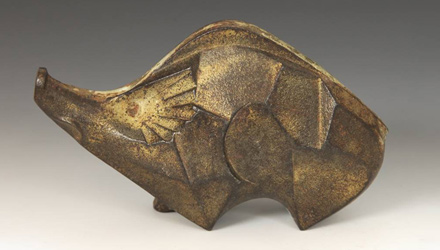 |
Download this Article: Honored by the Jade Emperor – The Chinese Zodiac.pdf